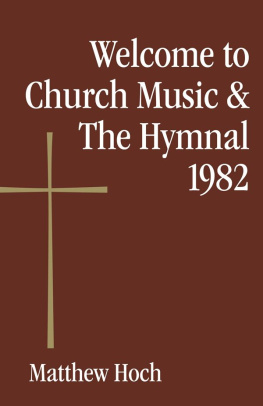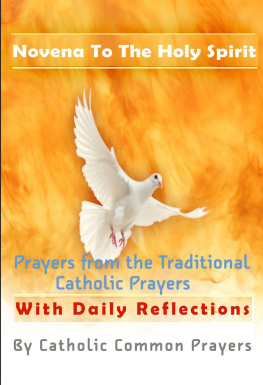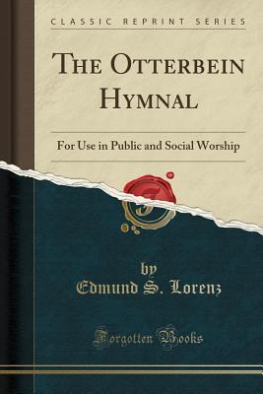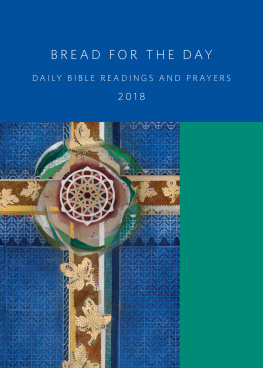A Liturgical Index
to
The Hymnal 1982
by Marion J. Hatchett
CHURCH PUBLISHING
an imprint of
Church Publishing Incorporated, New York
Copyright Marion J. Hatchett 1986
All rights reserved.
10 9 8 7 6 5 4
Church Publishing
Incorporated
445 Fifth Avenue
New York. NY 10016
Table of Contents
Introduction
The primary purpose of this index is to provide help in the selection of suitable hymns for the various rites of the Church and for different days and seasons of the Church Year. It should also be helpful in suggesting suitable organ music, anthems, and solos for organists, choir directors, and cantors.
This index lists hymns for use in the Daily Offices and the Holy Eucharist for every day or occasion for which the Book of Common Prayer provides propers. It also suggests hymns for Holy Baptism, for the Pastoral Offices, and for the Episcopal Services of the Book of Common Prayer; for various rites in the Book of Occasional Services; and for each of the propers of Lesser Feasts and Fasts.
One of the most important parts of the planning and preparation for any service is the choice of hymns. Hymns are one of the most vital elements in the participation of the congregation. Hymns set the mood for the rite. Hymns provide a congregational response to lessons and sermons and other important elements in the rites. Hymns are the peoples take home package. Because of the musical association people commit hymns to memory more easily and readily than prayers or psalms or other scriptural passages; therefore, the texts of hymns are more likely to recur to people than other texts. Peoples theology is probably influenced more by the hymns they sing than by the lessons and sermons they hear or the prayers they pray.
Each of the Daily Offices includes one rubric suggesting the possible use of a hymn (after the prayer for mission in both Morning and Evening Prayer, before the Psalmody in An Order of Service for Noonday, after the Lesson in Compline). The Hymnal 1982 provides several office hymns for each of the Daily Offices. This index suggests suitable hymns for Morning and Evening Prayer, mostly chosen because of a relationship to the Psalms or Lessons of the Daily Office Lectionary, Year One and Year Two. Hymns from among these suggestions also might be used quite suitably at Noonday and at Compline. Even when no hymn is sung, especially when a person is reading the office individually, the suggestions of this index would provide suitable devotional material related to the lectionary.
Hymns are suggested for each point in the Eucharistic Rite at which a hymn is allowed by the rubrics: before the Opening Acclamation (Entrance Hymn), after Lessons (Sequence), while the offering is being received and placed on the altar (Offertory Hymn), during the Communion of priest and people (Communion Hymn), and before or after the Post-communion Prayer (Postcommunion Hymn). It should be noted that the rubric in earlier Prayer Books allowing additional hymns before and after any service or sermon has been quite deliberately deleted. The Book of Common Prayer in no case allows a hymn between Gospel and Sermon. Only three rites allow a hymn after the dismissal: The Celebration and Blessing of a Marriage, The Burial of the Dead, and The Ordination of a Bishop (rites which involve unique situations in relation to the procession out of the church). A rubric peculiar to the 1892 edition of the Prayer Book which allowed a hymn at the presentation of the alms is also missing.
The Entrance Hymn sets the tone for the entire service. It may either cover or follow the entrance of the liturgical ministers. The way in which the hymn is used or the number of persons in an entrance procession will sometimes determine the suitability of a hymn that in other circumstances would be a very good choice for the opening of the rite.
The Sequence traditionally follows the Second Lesson (the First Lesson is normally followed by the Psalm which is known as the Gradual). It may provide a reflection on or a response to the Lesson, Psalm, or Epistle which have preceded, or it may anticipate the Gospel which follows. In the late medieval liturgical books it was normally sung immediately after the proper Alleluia Verse (a verse of Scripture introduced and followed by alleluias which has traditionally preceded the reading of the Gospel). Occasionally, however, the Sequence took the place of the Alleluia Verse or preceded it. Decisions as to whether both are used, and as to which should precede the other, should be made on the basis of the lectionary texts and of the texts and musical forms of the Sequence and of the Alleluia Verse (or of the Psalm known as the Tract which replaces the Alleluia Verse in Lent). Hymns that are very long or that arouse the most vigorous congregational participation can sometimes seem to cause the movement of the Liturgy of the Word to fall apart, or can constitute a premature climax, before the reading of the Gospel and the sermon. Oftentimes a careful selection of stanzas is better than the use of a whole hymn at this point in the rite.
The hymn at the Offertory is the first hymn after the Gospel and sermon. Ideally it should provide a congregational response to the Liturgy of the Word and serve as preparation for participation in the Great Thanksgiving and the Communion which follow. Care should be exercised lest this hymn be so overpowering that, rather than preparing people for their common participation in the great Thanksgiving, it causes this high point in the rite to come across as an anti-climax.
Historically great Psalms of praise, especially 145, 148, and 150, have been associated with the Communion of priest and people. Joyous music is especially appropriate at this climactic point in the rite. Hymns used at this point should not be confined to those from the Holy Eucharist section of the Hymnal. Great hymns of praise which echo the propers of the day are especially appropriate. Hymns with refrains, which enable people to sing as they move to and from the Communion stations, are especially good for use at this point in the rite when the text is appropriate.
The Postcommunion Hymn is the hymn which people are most likely to take with them from the Church, most likely to hum or whistle around the parish house, in the parking lot, or at other times and in other places. This hymn colors their feeling about the entire service which has preceded. Ideally this should be a very familiar hymn based on propers of the day which sends people out, rejoicing in the power of the Holy Spirit, to love and serve the Lord in the world.
In choosing hymns for a particular occasion consideration needs to be given to a number of factors, including the average age of the congregation, the size of the group and their musical abilities, the available vocal and instrumental leadership, the architectural setting (including the size and acoustics of the building), and the relative importance of the day or occasion. When several hymns are used there should be a balance of the familiar and the not quite so familiar.
The Hymnal suggests alternative tunes for a number of hymns. Even when the tune printed with the text is known by the congregation the alternative suggested might be better at certain points in the rite (for example, Dundee would surely be better as a procession from the Church than St. Agnes, printed with Shepherd of souls, refresh and bless). Use of the suggested alternative tunes allows for the use of a greater number of texts. An even fuller use of the texts of the book can be achieved by judicious use of the Metrical Index, pages 1, 039-1, 044.
This index should also suggest to organists, choir directors, and cantors appropriate organ music, anthems, and solos for the various rites and occasions in one or the other of three ways:


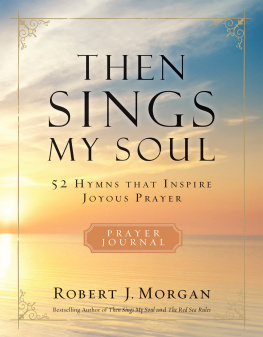
![The Standing Commission on Liturgy and Music - Daily Prayer for All Seasons [English Edition]](/uploads/posts/book/411072/thumbs/the-standing-commission-on-liturgy-and-music.jpg)
